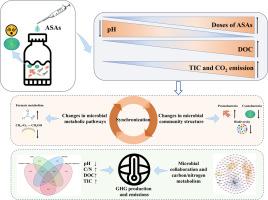当前位置:
X-MOL 学术
›
Water Res.
›
论文详情
Our official English website, www.x-mol.net, welcomes your
feedback! (Note: you will need to create a separate account there.)
Unraveling the mechanism of greenhouse gas emissions during allelochemical-triggered inhibition of cyanobacteria recovery
Water Research ( IF 11.4 ) Pub Date : 2025-06-01 , DOI: 10.1016/j.watres.2025.123943
Yushen Ma, Xiaoming Zhu, Hui Chen, Lixiao Ni, Cunhao Du, Chu Xu, Jiahui Shi, Yiping Li, Shiyin Li
Water Research ( IF 11.4 ) Pub Date : 2025-06-01 , DOI: 10.1016/j.watres.2025.123943
Yushen Ma, Xiaoming Zhu, Hui Chen, Lixiao Ni, Cunhao Du, Chu Xu, Jiahui Shi, Yiping Li, Shiyin Li

|
Climate change amplifies cyanobacterial blooms, creating a feedback loop between warming and bloom intensity. This dynamic emphasizes the need to address greenhouse gas (GHG) emissions during in-situ cyanobacterial control, minimizing algicides use and its long-term climatic impacts. However, research on the dose-response of algicides on GHG emissions is limited. This study investigated the dose-dependent effects of artemisinin sustained-release algicides (ASAs) on GHG emissions and microbial dynamics during cyanobacteria recovery prevention. Microcosm experiments revealed that ASAs dosage reshaped the carbonate system, lowering pH and increasing DOC and C/N ratio, promoting short-term CO₂ emissions. Microbial diversity decreased with higher ASAs dosage, and Proteobacteria replaced Cyanobacteria as the dominant group. The formate metabolic pathway, which produces CO₂, was strengthened, while CH₄ oxidation was weakened. The abundance of genera such as Curvibacter, Burkholderiales, and Acetobacterales increased, correlating with enhanced carbon and nitrogen metabolism, while CH₄-oxidizing genera like Methylobacterium and Methylorubrum showed reduced abundance, associated with weakened CH₄ metabolism. Co-occurrence networks emphasized that the ASAs gradient indirectly affected dominant microbes and carbon-nitrogen metabolism by altering water chemistry. ASAs exacerbated GHG emissions by coupling environmental changes with microbial metabolism. Our findings provide a theoretical basis for using lower ASAs dose during cyanobacteria recovery prevention and underscore the importance of considering biogeochemical cycles and ecosystem impacts in cyanobacterial control.
中文翻译:

揭示化感化学触发抑制蓝藻恢复过程中温室气体排放的机制
气候变化放大了蓝藻水华,在变暖和水华强度之间形成了一个反馈循环。这种动态强调了在原位蓝藻控制期间解决温室气体 (GHG) 排放问题的必要性,最大限度地减少杀藻剂的使用及其长期气候影响。然而,关于杀藻剂对温室气体排放的剂量反应的研究是有限的。本研究调查了青蒿素缓释杀藻剂 (ASA) 在预防蓝藻恢复过程中对温室气体排放和微生物动力学的剂量依赖性影响。微观实验表明,ASA 的用量重塑了碳酸盐系统,降低了 pH 值并增加了 DOC 和 C/N 比率,促进了短期 CO₂ 排放。微生物多样性随 ASAs 用量的增加而降低, 变形菌门取代蓝细菌门成为优势类群。产生 CO₂ 的甲酸盐代谢途径得到加强,而 CH₄ 氧化作用减弱。Curvibacter、Burkholderiales 和 Acetobacterales 等属的丰度增加,与碳和氮代谢增强相关,而 Methylobacterium 和 Methylorubrum 等 CH₄ 氧化属的丰度降低,与 CH₄ 代谢减弱有关。共生网络强调 ASA 梯度通过改变水的化学性质间接影响优势微生物和碳氮代谢。ASA 通过将环境变化与微生物代谢相结合,加剧了温室气体排放。我们的研究结果为在蓝藻恢复预防过程中使用较低剂量的 ASA 提供了理论基础,并强调了在蓝藻控制中考虑生物地球化学循环和生态系统影响的重要性。
更新日期:2025-06-02
中文翻译:

揭示化感化学触发抑制蓝藻恢复过程中温室气体排放的机制
气候变化放大了蓝藻水华,在变暖和水华强度之间形成了一个反馈循环。这种动态强调了在原位蓝藻控制期间解决温室气体 (GHG) 排放问题的必要性,最大限度地减少杀藻剂的使用及其长期气候影响。然而,关于杀藻剂对温室气体排放的剂量反应的研究是有限的。本研究调查了青蒿素缓释杀藻剂 (ASA) 在预防蓝藻恢复过程中对温室气体排放和微生物动力学的剂量依赖性影响。微观实验表明,ASA 的用量重塑了碳酸盐系统,降低了 pH 值并增加了 DOC 和 C/N 比率,促进了短期 CO₂ 排放。微生物多样性随 ASAs 用量的增加而降低, 变形菌门取代蓝细菌门成为优势类群。产生 CO₂ 的甲酸盐代谢途径得到加强,而 CH₄ 氧化作用减弱。Curvibacter、Burkholderiales 和 Acetobacterales 等属的丰度增加,与碳和氮代谢增强相关,而 Methylobacterium 和 Methylorubrum 等 CH₄ 氧化属的丰度降低,与 CH₄ 代谢减弱有关。共生网络强调 ASA 梯度通过改变水的化学性质间接影响优势微生物和碳氮代谢。ASA 通过将环境变化与微生物代谢相结合,加剧了温室气体排放。我们的研究结果为在蓝藻恢复预防过程中使用较低剂量的 ASA 提供了理论基础,并强调了在蓝藻控制中考虑生物地球化学循环和生态系统影响的重要性。


















































 京公网安备 11010802027423号
京公网安备 11010802027423号